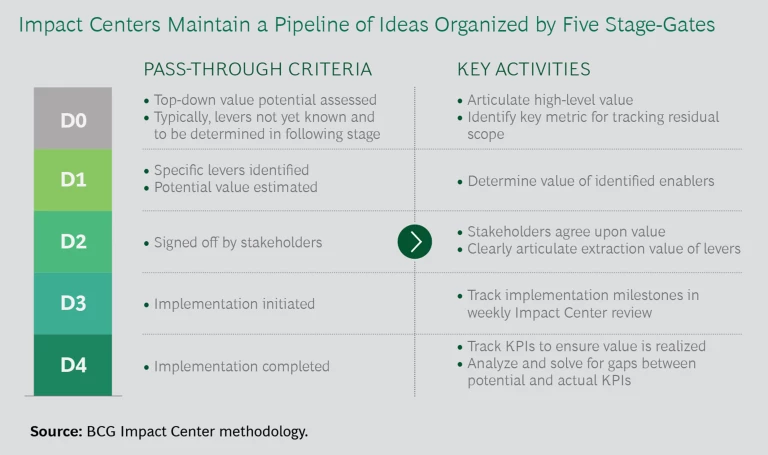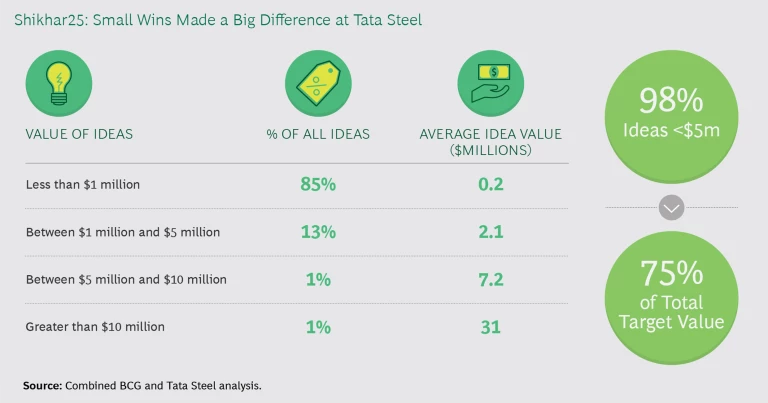It’s tough to get a tiger to change its stripes, as CEOs are acutely aware. Few business leaders have succeeded in getting large corporations to change, to continually evolve, and to hardwire the capabilities for change into the organization, so they’re ready to transform themselves in future, too.
In fact, most companies don’t have a great track record of managing change. Around 50% of change initiatives fail to achieve their objectives, while as many as 75% of complex enterprise-wide projects collapse under their own weight, according to BCG research. That’s why a recent initiative at one of the world’s largest integrated steel producers, Tata Steel, offers powerful lessons for how big companies can effectively manage change.
Five years ago, trapped by the pincers of rising raw-material costs and falling product prices, India’s Tata Steel tried to turn its crisis into an opportunity. Led by the CEO (T. V. Narendran, one of this article’s authors) and its top management team, the company mounted a change initiative across its operations that was unprecedented in terms of size, scale, and speed. In this article, we’ll describe how Tata Steel managed to bring about change quickly at a critical juncture; used the process to inject change management into its organizational DNA; and highlight the key lessons that companies everywhere can learn from Tata Steel’s remarkable turnaround.
Caught in a Crunch
In 2014, global steel prices went into free fall. India’s steel industry was hit hard, with prices tumbling 30% over the span of a year. Regulatory changes compounded the problem, temporarily choking off Tata Steel’s supplies of iron ore and coal from its captive mines in eastern India—one of the company’s key sources of competitive advantage for over a century. Like its rivals, Tata Steel was forced to purchase raw materials from the open market, leading to costs that soared by double digits. Consequently, Tata Steel’s profits (as measured by EBITDA) fell by approximately 25% between 2014 and 2015.
Tata Steel, no stranger to the inherently cyclical nature of the steel industry, decided that it was time to look beyond the immediate challenges it faced. Rather than applying short-term fixes, the company sought to boost its long-term profitability by launching a major change initiative that would increase throughput, improve quality, and reduce costs—permanently. None of the changes, the company vowed, could result in one-time additions to the bottom line; they would have to be sustainable. In the process, Tata Steel hoped to add as much as $1 billion to its bottom line in three years flat.
This was an audacious goal, especially given Tata Steel’s position as a large, well-established market leader. At the time, the company employed approximately 6,000 managers and 36,000 workers throughout India in a vertically integrated operation. It operated in an industry characterized by comparatively traditional organizational structures, a unionized workforce, and large capital investments. While the company would have to execute the change initiative at scale to generate results, it could not divert resources from its long-term capital investment projects.
Moreover, Tata Steel was coming off a series of major process-improvement and cost-saving initiatives it had been working on since the early 1990s, including total quality management (TQM), total preventive maintenance (TPM), and theory of constraints (TOC) programs. In other words, the company couldn’t simply reach for low-hanging fruit. A new initiative would have to look even deeper and harder into the organization for savings and efficiencies, which made the $1 billion profit target seem even harder to reach.
None of the changes could result in one-time additions to the bottom line; they would have to be sustainable.
A Bold Solution
Although the odds were stacked against it, Tata Steel launched a company-wide change initiative in 2015 called Shikhar25 —named as such because “Shikhar” is the Sanskrit word for “peak,” while 25 represented the company’s profitability goal for its steel business, assuming it would pay market prices for raw materials.
By 2018, the program had added no less than $1.2 billion (in real terms, published in annual reports) to Tata Steel’s bottom line, meaning the company exceeded its initial target by 20%. As a result, its cash position improved three-fold, and profits grew faster than steel prices, on a per-ton basis, throughout that period.
Designing Change
Before kicking off Shikhar25, based on its past experience, Tata Steel chose to rethink the underlying design rules of the change initiative. That led to the following design principles:
- Employee Ownership. Tata Steel’s top management felt strongly that Shikhar25 would succeed only if middle managers and workers owned and drove the program themselves. It would take the active involvement of every employee across the entire organization to ensure that the change process gathered the scale, scope, and speed needed to deliver results—quickly.
- Risk Taking. Shikhar25 would have to draw heavily on senior executives’ expertise in change management to help catalyze riskier projects going forward. It was unlikely that easy or obvious changes would yield results, so the top team would have to encourage risk taking by middle managers and workers, and help them overcome their fear of failure.
- Structured Problem Solving. Tata Steel needed to deploy more rigorous approaches to finding and solving problems in order to boost efficiency. Managers would have to consistently apply new techniques and technologies, such as A3 problem solving and advanced analytics, to ensure continuous, data-driven improvements.
- Seamless Integration. Every part of the change would need to be woven into Tata Steel’s routine business processes and projects, so that new initiatives didn’t result in an onerous burden on employees. Otherwise, Shikhar25 would fail to get off the ground.
- Ease Of Reporting. Shikhar25 could only bring rapid change with minimal governance. It’s common for large-scale change programs to have frequent and complex reporting to—and reviews by—multiple levels of senior management. However, Tata Steel needed to show results quickly, so the emphasis had to be on doing rather than monitoring.
- Sustainable Change. Tata Steel wanted Shikhar25 to create capabilities for continuous change in the future. The program incentivized middle managers and workers to upskill themselves so that the company was ready to change whenever needed.
Where It All Happened
The guidelines for Shikhar25 were clear, but Tata Steel required an engine to drive the initiative forward. After carefully weighing its options, the company decided to use an innovative structural solution, the Impact Center, to plan, execute, manage, and monitor change projects.
Impact Centers are physical rooms supported by specific routines that engage employees in change. At the most basic level, an Impact Center is a meeting space for managing change projects that displays all the relevant data, but more deeply, serves as the unit of change at the department level. Each center is led by a “sponsor” (the department head), facilitated by a “champion” (either an executive or high-performing middle manager), and brought to life by “change agents,” made up of middle managers and workers. Visual displays in the Impact Center link performance metrics with change initiatives, placing ownership in the hands of employees and enabling them to drive improvements in their everyday work.
Tata Steel opened an Impact Center in every operating unit, led by each unit’s head. There was no top-down goal setting; middle managers in each Impact Center developed their own goals and targets, made decisions, and monitored progress.
Governance was lean. Each Impact Center held meetings only once a week, followed by a leadership review of project-related centers every three weeks. Many of the reviews replaced or were merged with existing meetings to ensure that the new way of working didn’t take too much of people’s time.
At the weekly meeting, all of the operating unit’s line managers, as well as relevant executives from other functions, met in the Impact Center. Before the meeting began, the owners of each change project updated the data on the charts on the walls; they could not use slide decks as a rule. In addition to being quick and easy, the use of hand-drawn charts symbolized the managers’ ownership of change projects and their responsibility for those targets.
Each meeting was a standing-only event, lasting 45 minutes at most, designed to remove emerging bottlenecks, discern next steps, and align stakeholders. Managers discussed ideas, drew up plans, identified upskilling requirements, and galvanized each other to action. Due to the presence of executives from other functions, such as procurement, HR, and finance, cross-functional issues could be resolved immediately. Participants left meetings knowing exactly what they needed to accomplish in the next one week to meet their Shikhar25 targets. (See “Tata Steel’s Lexicon of Change.”)
TATA STEEL’S LEXICON OF CHANGE
TATA STEEL’S LEXICON OF CHANGE
During any change initiative, it’s important to create a lexicon so people can communicate effectively about the changes they’re bringing about. Having a common terminology for change projects facilitates discussion, understanding, and comparison.
Tata Steel’s Shikhar25 change initiative used a color-coded, five-stage-gate classification system that became its organizational terminology to capture ideas, execute projects, and monitor impact. Every project passed through the stage-gates, from D-0 to D-4, gaining maturity from ideation to implementa-tion. (See the exhibit below.)
- At the D-0 stage, each Impact Center held an aspiration-driven workshop to generate ideas and calculate the best demonstrated performance on the related parameters, which provides an estimate of the opportunity size and possible targets. For instance, one Impact Center hypothesized that it’s possible to reduce the lime used in the steel-manufacturing process, which would reduce costs.
- At the D-1 stage, the unit conducted analyses to identify the levers needed to achieve this opportunity. It found that shop floor operators were adding too much lime because the weighing system wasn’t accurate enough.
- At the D-2 stage, the unit set up a team to address the issue, identified the specific change initiatives needed, and created a work plan.
- At the D-3 stage, after receiving key stakeholder sign-offs on the work plan, the implementation phase began, resulting in the weighing system’s periodic recalibration by internally trained operators.
- Finally, at the D-4 stage, the value was realized and the post-implementation tracking and troubleshooting began. In the case of lime reduction, the Impact Center asked questions around the new baseline, daily consumption, and the opportunity to limit the resource’s usage further.
The stage-gate system made it easy for Tata Steel’s managers to discuss where they were at in the process and the stage at which value was realized.
A full-time champion, who went through a rigorous onboarding process and continuous training, oversaw each Impact Center. Champions were usually high-performing middle managers from the unit, trained in the processes and practices that would optimize its functioning. They worked with the unit’s stakeholders to identify opportunities for improving yields and quality, saving costs, and boosting throughput—while facilitating implementation and resolving problems as they arose. Champions also brought in external expertise and used technology-based and analytics capabilities to strengthen their centers’ outcomes. These facilitators returned to the company’s line functions after spending a year or two with the Impact Centers, thereby adding to the organization’s continuous-change-management capabilities.
The Outcome
Over three years, Tata Steel created 22 Impact Centers in a calibrated rollout. The company initially deployed them in the operations departments, where it could find the largest, and relatively easiest to extract, value pools. It then set up Impact Centers in service departments, where capturing value required greater coordination due to their inherently cross-functional nature. Finally, Tata Steel established some Impact Centers at the intersection of its operations and service departments, where value extraction was toughest.
Impact Centers divided an ambitious organizational goal into several smaller projects. Using Impact Centers allowed Tata Steel to ensure that middle managers and workers felt responsible for conceptualizing, executing, and delivering results as part of the Shikhar25 initiative. It also simplified governance, created direct links between top management and the organization’s frontlines, and built an important capability for continuous change, as employees left Impact Centers with broader skills they could apply to their day jobs.
Using Impact Centers allowed Tata Steel to ensure that middle managers and workers felt responsible for conceptualizing, executing, and delivering results.
Tata Steel’s Change Playbook
Shikhar25 offers six critical lessons for organizations wishing to bring about change quickly.
Engage every employee. Companies require the full power of their workforces to push the pace of change and generate the ideas needed for improvement. Tata Steel launched Shikhar25 in a massive auditorium near its headquarters in Jamshedpur and streamed the event live to more than ten locations in the country to cover its entire workforce. Along with Tata Steel’s entire top management team, the leader of the Tata Workers Union was also on stage, symbolizing the company’s trade unions’ support for the change initiative.
At this event, Tata Steel’s leadership team laid out Shikhar25’s ambitious goals, and middle managers and union representatives translated them into a call for value-creating ideas. As mentioned, Tata Steel’s top management didn’t develop a Shikhar25 strategy that middle managers and employees only had to execute; the latter developed goals and objectives themselves. Shortly after the event, all departments and employees were mapped to Impact Centers, which soon buzzed with idea-generation sessions, brainstorming of solutions, and the coming together of cross-functional stakeholders in the quest to deliver more with less. Shikhar25’s broad-based ownership ensured results rapidly.
Make middle managers responsible for change. As the link between top management and frontline employees, middle managers are critical to the success of change initiatives. During Shikhar25, Tata Steel’s middle managers, who knew company operations like the back of their hands, were able to identify pockets of value that would have been impossible for almost anyone else to spot.
Middle management also instinctively identified the challenges they would face in capturing that value, and figured out how to overcome them. When knotty issues cut across departments, for instance, middle managers collaborated with peers to get things done, which was far more effective than escalating issues through the formal hierarchy. The middle managers’ ownership of Shikhar25 had a cascading impact on the organization. Their efforts and enthusiasm inspired workers, ensuring quicker execution and further idea generation.
Use top management as change catalysts. Tata Steel’s leadership was fully involved in the Shikhar25 change program and took responsibility for its overall performance. Senior executives participated actively in Impact Center reviews, joined brainstorming sessions to find new sources of value, and celebrated success alongside the entire team.
Executives were also responsible for disseminating best practices across the organization, stretching middle managers’ ambitions, and ensuring organizational renewal through the adoption of new capabilities such as advanced analytics and digital technologies. Unsurprisingly, the involvement of Tata Steel’s senior executives inspired middle management to put its best foot forward, while also breaking down siloed perspectives.
Look for many small wins. Shikhar25 focused on immediate execution and impact, as opposed to harder-to-attain goals. Most companies hunt for large value-creation opportunities when pursuing change-related goals, and as a result, those smaller ideas that are often proposed by workers or middle managers fail to grab attention or to gain traction. Capturing each of these ideas during a change initiative can be quite rewarding.
At Tata Steel, over 98% of the change projects created less than $5 million in value each, and yet collectively, contributed to approximately 75% of the total target. Small wins ensured that Shikhar25 exceeded its big goal. (See the exhibit.) In addition to unlocking value, the successful implementation of small ideas created excitement among employees, led to more ideas, and sustained the process over time. Executing small-scale projects, Tata Steel’s experience suggests, generates a steady cadence for a large change initiative.
Create continuous change. During any change initiative, global or local benchmarks are useful for target-setting, but they are at times easily achievable, and at others nearly impossible. Tata Steel overcame this problem by using historical best demonstrated performance (BDP) as a starting point. Setting benchmarks at the 80th percentile ensured that operating units could sustainably raise their average performance in the future.
The units then worked to achieve that goal, breaking down the process into discrete projects that could be executed speedily. As results came in, each unit’s BDP began to rise, triggering fresh and relatively bigger aspirations for the stage ahead. This dynamic allowed Tata Steel to focus on successive, and mounting, waves of idea generation, execution, and value capture.
For instance, in the company’s underground coal mines, the deeper the blast, the more coal that it could extract. Tata Steel had achieved an average blast depth of around 1.3 meters, and at the time of the transformation, the deepest it had ever reached was approximately 1.6 meters. By comparing and standardizing the blasting techniques used in different sections of the mines, Tata Steel first managed to increase the average blast depth to 1.5 meters. The new target that followed was 1.7 meters, which pushed the team to rethink the blasting process. The team then changed the pattern in which the explosives were placed, resulting in a new average of 1.6 meters—a depth that was not so long ago an exception to the rule.
Develop new capabilities. Capability development is critical for sustaining change initiatives, both in the short and long term. Tata Steel knew from experience that executing ambitious change programs drains the organization, leading to a loss of momentum. Companies need to build renewal into the process, which is why developing fresh capabilities during the change initiative is critical.
To sustain the value generated by the new change projects, and to identify fresh sources of value, Tata Steel focused on upskilling talent across the organization. During Shikhar25, the company focused on training employees in the use of emerging digital technologies, such as artificial intelligence and machine learning. This way, they could use the mountain of data collected by the company over the years to develop data-driven insights that would optimize performance. (See “Using Digital Tools for Change.”)
USING DIGITAL TOOLS FOR CHANGE
USING DIGITAL TOOLS FOR CHANGE
At Tata Steel, improvement opportunities were tough to spot, which is why the company turned to digital technologies during Shikhar25 to uncover them. For instance, the Impact Center in the steel-melting shop came up with several ideas about how to improve crude steel throughput. Every idea seemed promising, but it was unclear which would be able to boost throughput in the most cost-effective fashion.
The Impact Center’s champion felt overwhelmed, so he turned to a digital twin that modelled the manufacturing process on a computer system. Throughout the process, he involved the unit’s managers and operators to define the key assumptions underlining the model, so that it could accurately capture the nuances and constraints the system’s users faced each day. This move helped conclusions from the analysis gain acceptance among the operations team. Moreover, the Impact Center trained some young engineers in the unit in the use of the digital twin, which not only added digital capabilities to the department, but also supported Tata Steel’s broader ability to ensure continuous change.
A steel shop consists of many moving pieces of equipment, from cranes to ladle furnaces, and each breaks down at a different time. Identifying and prioritizing the major bottleneck is therefore a complex, and ever-shifting, challenge. By mimicking the steel shop’s operations on a system, managers and operators were able to figure out the key challenges and what would happen if they applied countermeasures. By making assumptions about the mean time between failure and repair for each piece of equipment, and creating what-if scenarios, the digital twin helped the team hone in on the major problem.
Contrary to the team’s initial assumptions, the plant’s electric overhead travelling crane, although indispensable, created a major bottleneck whenever it broke down. If the crane stopped working, the steel-making process came to a dead halt. Realizing the severity of this issue, the unit started to ensure that the crane always worked, which involved maintaining it at the highest possible level of availability.
The steel shop was able to increase throughput without incurring major capital expenditure through the use of a digital twin. At the end of the day, approximately 20% of Shikhar25’s captured value came from the marriage of Big Iron and Big Data.
Tata Steel developed a formal capability development program, “Act Now!,” whose curriculum focused on upskilling employees across levels and functions. The process was driven by classroom coaching, immersion visits to other companies, learning programs, on-the-job assignments, and mentorship. At the same time, the company also brought in many global experts to stay on the cutting edge, and inculcated a methodical, rigorous approach to problem solving by conducting agenda-based workshops.
Celebrate. Recognize. Reward. Repeat. Every company talks about celebrating success, but few manage it as effectively as Tata Steel did during Shikhar25. For instance, whenever a unit achieved a business target or set a record on a key performance indicator, managers would ceremonially cut a cake at the end of the weekly meeting in the Impact Center. Additionally, middle managers were given a small budget to reward shop floor workers for a number of reasons, including a job well done, participation in ideation and implementation, and for bringing new ideas to the table. These awards were publicly handed out every month, which helped employees gain respect amongst peers and just as importantly, family.
Tata Steel even organized annual award nights, which is unusual in the steel industry. At these events, top management gave away awards in different categories, celebrating the best ideas, highest value creation, and the most collaborative efforts brought by employees. Recognizing employee efforts boosted morale and was essential to sustaining the initiative.
The Bottom Line
Perhaps unsurprisingly, Tata Steel has institutionalized the processes and organization structure of Shikhar25 to drive future change in the organization, a move whose results can already be seen. When Tata Steel recently acquired an ailing steel company in India, Bhushan Steel Limited (now Tata Steel BSL), it used the Shikhar25 methodology to transform the company in less than 18 months’ time. It’s clear that Tata Steel has developed processes and structures that enable it to bring about rapid, large-scale, and systemic change whenever circumstances demand—a highly coveted, dynamic advantage in a fast-changing world.








